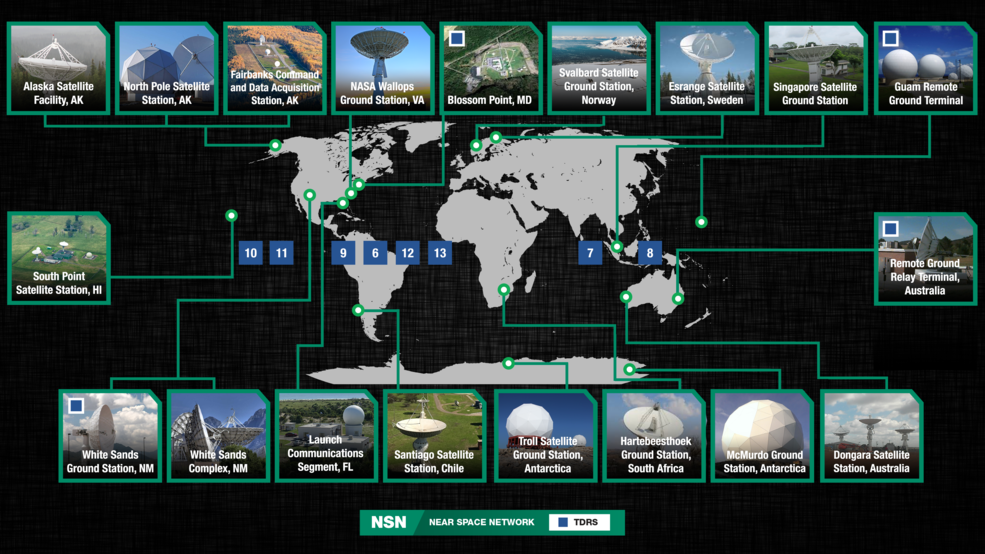
Posted on 6th January 2025 | Modified on 6th January 2025
Four companies have won Nasa contracts to expand the agency’s Near Space Network. Specifically, its commercial “direct-to-Earth capabilities” services.
Nasa describes this function as “a mission-critical communication capability that allows spacecraft to transmit data directly to ground stations on Earth”.
The companies are: Intuitive Machines (USA), Kongsberg Satellite Services (Norway), SSC Space (USA) and Viasat (USA).
The network supports NASA’s missions ranging from climate studies on Earth to astronomy research. It will also play a role in NASA’s Artemis campaign, which involves long-term exploration of the Moon.
The Near Space Network provides missions – out to 1.2 million miles (2 million km) – with communications and navigation services. For example to the ISS and Earth-observing missions.
The maximum value of all the Near Space Network Services (firm-fixed-price) contracts is $4.82 billion.
Project timelines span from February 2025 to September 2029. But there is an additional five-year option period that could extend a contract to September 2034.
The details of the awards are as follows (in Nasa’s own words):
Intuitive Machines of Houston will receive two task order awards on its contract for Subcategory 1.2 GEO to Cislunar Direct to Earth (DTE) Services and Subcategory 1.3 xCislunar DTE Services to support NASA’s Lunar Exploration Ground Segment, providing additional capacity to alleviate demand on the Deep Space Network and to meet the mission requirements for unique, highly elliptical orbits. The company also previously received a task order award for Subcategory 2.2 GEO to Cislunar Relay Services.
Kongsberg Satellite Services of Tromsø, Norway, will receive two task order awards on its contract for Subcategory 1.1 Earth Proximity DTE and Subcategory 1.2 to support science missions in low Earth orbit and NASA’s Lunar Exploration Ground Segment, providing additional capacity to alleviate demand on the Deep Space Network.
SSC Space U.S. of Horsham, Pennsylvania, will receive two task order awards on its contract for Subcategories 1.1 and 1.3 to support science missions in low Earth orbit and to meet the mission requirements for unique, highly elliptical orbits.
Viasat, of Duluth, Georgia, will be awarded a task order on its contract for Subcategory 1.1 to support science missions in low Earth orbit.
The network enables spacecraft to exchange critical data with mission operators back on Earth. Using space relays in geosynchronous orbit and a global system of government and commercial direct-to-Earth antennas on Earth, the network brings down terabytes of data each day, says Nasa.
Locations of Near Space Network ground stations and Track Data and Relay Satellites are pictured above.
The Network is comprised of ground stations, across the world, and Tracking Data and Relay Satellite (TDRS) systems in geosynchronous orbit.
The ground stations provide Direct-to-Earth (DTE) communications while TDRS satellites provide “near continuous bent pipe information relay services” says Nasa. Missions supported include the Hubble Space Telescope and the International Space Station. And also Earth-observing missions like Global Precipitation Measurement, Terra and Aqua.
You can read more about the Near Space Network on the Nasa website.
Image: Nasa
See also: NASA selects Intuitive Machines for lunar South Pole payload delivery
Tagged with: nasa
Your email address will not be published. Required fields are marked *
*
*
Get our news, blogs and comments straight to your inbox! Sign up for the Electronics Weekly newsletters: Mannerisms, Gadget Master and the Daily and Weekly roundups.

Find out more »
Read our special supplement celebrating 60 years of Electronics Weekly and looking ahead to the future of the industry.
Read the Electronics Weekly @ 60 supplement » 
Read the first ever Electronics Weekly online: 7th September 1960. We’ve scanned the very first edition so you can enjoy it.
Read the very first edition »
Keep up with developments relating to space technology – satellite technology, PNT, thermal imaging, SatIoT, spaceports and more
View our busy aerospace section »
Image: ESA
Read our special supplement celebrating 60 years of Electronics Weekly and looking ahead to the future of the industry.
Read the Electronics Weekly @ 60 supplement » 
Read the first ever Electronics Weekly online: 7th September 1960. We’ve scanned the very first edition so you can enjoy it.
Read the very first edition »
Keep up with developments relating to the Internet of Things (IoT) – Industrial IoT, sensors, Edge AI, battery technology, SatIoT and more
View our popular Internet of Things section »
Image: ESA
Keep up with developments relating to Power electronics – MOSFETs, batteries, PSUs and more, for example
View our busy Power section »
Image: Infineon
